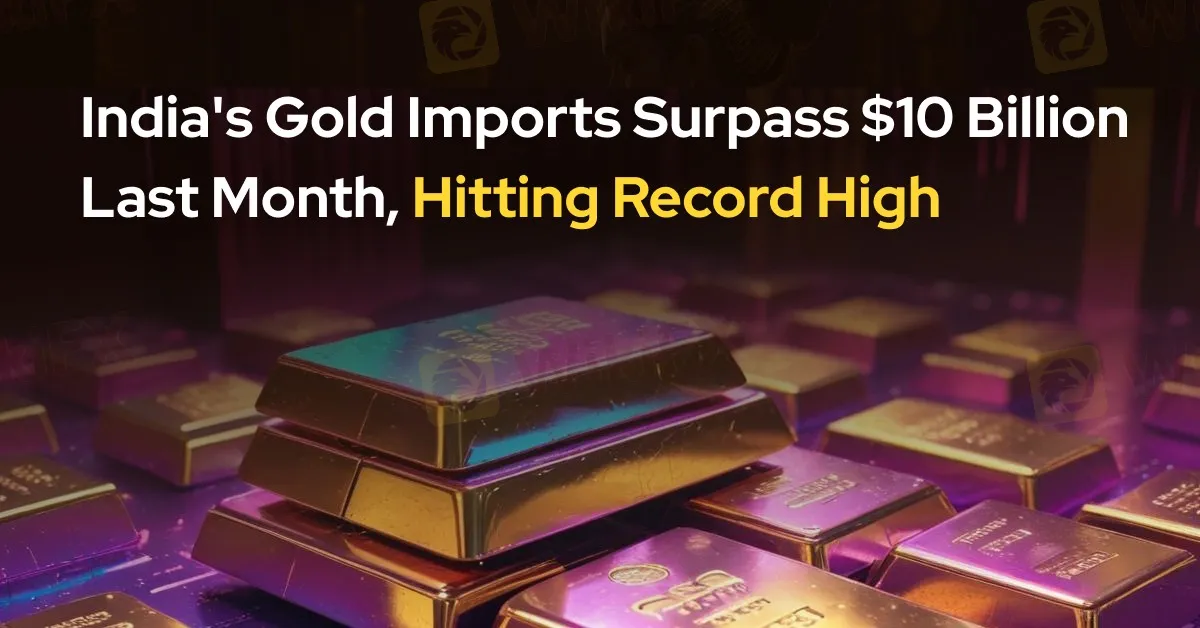简体中文
繁體中文
English
Pусский
日本語
ภาษาไทย
Tiếng Việt
Bahasa Indonesia
Español
हिन्दी
Filippiiniläinen
Français
Deutsch
Português
Türkçe
한국어
العربية
India's Gold Imports Surpass $10 Billion Last Month, Hitting Record High
Abstract:Recent reports indicate that following a reduction in gold import duties this summer, there has been a significant surge in consumer demand for gold jewelry and bars in India, driving global gold prices to unprecedented levels.

Recent reports indicate that following a reduction in gold import duties this summer, there has been a significant surge in consumer demand for gold jewelry and bars in India, driving global gold prices to unprecedented levels.
According to data from the Indian government released this week, the value of gold imports for August reached $10.06 billion, the highest ever recorded.
The surge in demand from Indian consumers for gold jewelry and bars has become a crucial factor propelling global gold prices to new heights. Preliminary estimates from consulting firm Metals Focus suggest that this amount represents approximately 131 tons of gold imports, potentially marking the sixth-highest import volume in history. Since the beginning of the year, international gold prices have risen by 25%. Typically, such high prices would deter price-sensitive buyers in Asia; however, the Indian market has shown surprising resilience. Notably, the Indian government‘s decision to cut gold import duties by 9 percentage points at the end of July has significantly boosted demand in the world’s second-largest gold consumer.
Philip Newman, managing director at Metals Focus, remarked, “The effects of the duty reduction are extraordinary and have truly drawn in consumers.”
The reduction in duties has provided a boost to jewelry retailers across India. At MK Jewelry in Mumbai's affluent Bandra West area, the enthusiasm among consumers is palpable. Store manager Ram Raimalani noted, “Demand is incredibly strong right now.”
Raimalani anticipates that during the peak wedding and festival season from September to February, the store's sales could rise by 40% compared to the previous year. He praised the Indian government and Prime Minister Modi for their decision to lower gold duties.
Data from the World Gold Council reveals that India accounted for approximately one-third of global gold jewelry demand last year, establishing itself as the second-largest market for gold bars and coins.
However, as international gold prices continue to climb, the sustainability of this strong domestic demand may become a pivotal issue. Harshal Barot, a senior research advisor at Metals Focus, expressed that the current high demand in the local market indicates that domestic gold prices are quickly rising to levels seen before the duty cuts.
Barot cautioned, “The benefits from the duty reduction are quickly fading. Prices are still on the rise, and we need to see if consumers continue to buy at this rate.”
Before the import duties were lowered, India's gold jewelry purchases had been declining, reaching their lowest level since 2020 in the first half of 2024.
Despite this, Raimalani is confident that jewelry demand in India will remain robust during the upcoming wedding season, regardless of whether gold prices retreat from their historical highs.
He commented, “Rising gold prices have not deterred my clients. In fact, Indians are often happiest when prices increase because they already own so much gold; its viewed as an investment.”
Even if consumer demand cools, the Reserve Bank of India is likely to maintain its position among global central banks increasing their gold reserves. In the first seven months of this year, the Reserve Bank added 42 tons to its gold holdings, more than double its total purchases for all of 2023.
A source familiar with the Reserve Bank's strategy noted that gold purchasing is part of its routine management of foreign exchange reserves and currency stability.

Disclaimer:
The views in this article only represent the author's personal views, and do not constitute investment advice on this platform. This platform does not guarantee the accuracy, completeness and timeliness of the information in the article, and will not be liable for any loss caused by the use of or reliance on the information in the article.
Read more

Geopolitical Events: What They Are & Their Impact?
You've heard many times that geopolitical events have a significant impact on the Forex market. But do you know what geopolitical events are and how they affect the FX market? Let us learn about it today.

Why Do You Feel Scared During Trade Execution?
Trade execution is a pivotal moment for traders. It is when analysis turns into action, and potential profits or losses become reality. However, for many traders, this moment is accompanied by fear. Why does this happen, and how can you address it?

WikiEXPO Global Expert Interview: Simone Martin—— Exploring Financial Regulation Change
In the midst of financial innovation and regulation, WikiGlobal, the organizer of WikiEXPO, stays abreast of industry trends and conducts a series of insightful and distinctive interviews on pivotal topics. We are delighted to have the privilege of inviting Simone Martin for an in-depth conversation this time.

MultiBank Group Wins Big at Traders Fair Hong Kong 2024
Discover how MultiBank Group, a global leader in financial derivatives, secured three prestigious awards at Traders Fair Hong Kong 2024, highlighting its innovative trading solutions and industry excellence.
WikiFX Broker
Latest News
Volkswagen agrees deal to avoid Germany plant closures
Geopolitical Events: What They Are & Their Impact?
Top 10 Trading Indicators Every Forex Trader Should Know
WikiEXPO Global Expert Interview: Simone Martin—— Exploring Financial Regulation Change
TradingView Launches Liquidity Analysis Tool DEX Screener
MultiBank Group Wins Big at Traders Fair Hong Kong 2024
'Young investors make investment decisions impulsively to keep up with current trends' FCA Reveals
Why Do You Feel Scared During Trade Execution?
CySEC Settles Compliance Case with Fxview Operator Charlgate Ltd
Scope Markets Review: Trustworthy or Risky?
Currency Calculator


